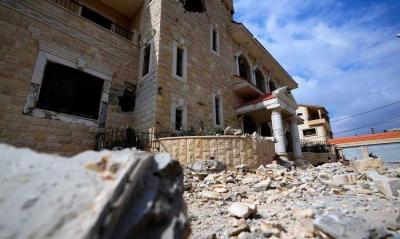The scene in the southern border towns and villages has revealed massive destruction in homes, infrastructure, and living conditions, making it difficult for displaced residents from these areas to return, even in the event of a truce between the Lebanese and Israeli sides, which coincides with international efforts to prevent the escalation of the war between Hezbollah and the Israeli army. Preliminary estimates suggest a staggering situation regarding the return of life to the towns and villages bordering the front with Israel, as reported by "Al-Anbaa" in Kuwait.
Complete displacement has affected 30 out of 37 villages in the Bent Jbeil district, as well as 28 out of 32 villages in the Marjeyoun district. Reports indicate that there are about 8,000 students studying remotely online, with a significant number of students transferred to schools in Tyre, Nabatieh, and the Association of the Mabarat schools in Beirut. Displacement has also occurred from Al-Khiyam, Kfar Kela, Adaisseh, Houlah, Tair Harfa, Al-Taybah, Aitta Shaab, Yaron, Al-Labounah, Sheihin, Al-Jabin, Barashit, and others. The majority of residents have relocated to nearby hills, such as in Hasbaya, in the Arqoub area near the Shebaa Farms, where the environment feels less targeted by the Israeli enemy compared to the front-line towns and villages.
There is a consensus on estimating the total number of displaced individuals at around 100,000, including 45,000 who have settled in the city of Tyre and its surroundings, while the rest have spread across various Lebanese regions, though most have not moved beyond the southern bank of the Awali River in Sidon. There have been wholesale announcements about relocating businesses, factories, and medical clinics from Bent Jbeil to Nabatieh, Tyre, and other towns, according to "Al-Anbaa." Estimates suggest that only 500 citizens remain in Al-Khiyam out of 10,000 who usually spend the winter there. The number of completely destroyed homes in Kfar Kela, facing the Metula settlement, has exceeded 560, with houses leveled to the ground and no signs remaining to indicate their existence, a scene that is echoed in other towns. The scale of destruction surpasses that witnessed during the July 2006 war, reflecting concerns about the return of residents after the expected silence of the artillery and the roar of Israeli warplanes and drones, which continue to bombard the areas, instilling fear among the residents who have endured for 24 hours, as the noise of the drones does not cease.
In the town of Dabchin, adjacent to Ja'diyeh Marjeyoun, Umm Hussein and her husband reopened their grocery store after a two-month closure, a store that had been operating for five years. The vegetable stand previously displayed by the woman, who is in her fifties, is no longer outside, as she feared spoilage due to the lack of commercial activity because of the low number of resident populations. Suppliers no longer visit these towns, forcing store owners to go to the city of Sidon to shop and replenish the shortages that have become evident on store shelves, as is the case in Hanna Edmond supermarket in the border town of Al-Qila'a.
A resident in Al-Bouida in Marjeyoun reported that bottled water has been unavailable for more than two months, which had been supplied to homes and shops. There have been complaints from teachers and students at a school in Marjeyoun, who launched a cry of pain directed at anyone unaware that part of the country is bleeding and walking the path of Golgotha, waiting for salvation. Meanwhile, some school officials have refused to subject their students to the official baccalaureate exams due to the suspension of in-person classes.
Regions lack basic life necessities, such as nearby hospitals equipped for emergencies, and the economic crisis casts its shadows over residents who need fuel for heating and freedom of movement without fear of being targeted by drones and warplanes. Movement ceases after sunset, especially near the Khardali Bridge, where there is a fixed monitoring point for the Lebanese army that separates the area covered by UN resolution 1701, which established a ceasefire after the July 2006 war, from the towns and villages leading to it. Several roads see little traffic, like the road from Kfar Kela to Al-Khiyam, as residents resort to bypassing through other towns that experience less Israeli targeting due to the low activity of resistance fighters there.
A man in his forties from Adaisseh shared the story of a young woman from Al-Khiyam who gave the key to her house to the youth (from the resistance), resulting in the complete destruction of her four-story building. The day after the war stops in southern Lebanon differs significantly from that witnessed in the south following the July 2006 war. There are no living conditions in towns facing numerous challenges, and their inhabitants rely on financial remittances from their expatriate children and relatives. Lebanese residents in Africa and the United States have invested their lifetime savings in homes exceeding $300,000 in total value. The Lebanese were not afraid of Israel and built their homes near the border strip erected in the north of the occupied Palestinian territories.
They built guesthouses outside their homes, intending to make them extensions, and people used to smoke shisha by the fence. The return to the front-line towns and villages seems challenging, as it requires full reconstruction needing vast sums. There is no need to discuss the unprecedented economic crisis hitting the country since late 2019, the freezing of deposits in banks, and the dramatic collapse of the Lebanese lira against the US dollar. However, Abu Mohammed took a deep puff from his handmade cigarette, made from tobacco he grew last season, selling most of it to the Régie. The eighty-year-old man told "Al-Anbaa" that they have become accustomed to facing hardships and challenges, and that people will return no matter how long the absence lasts.




